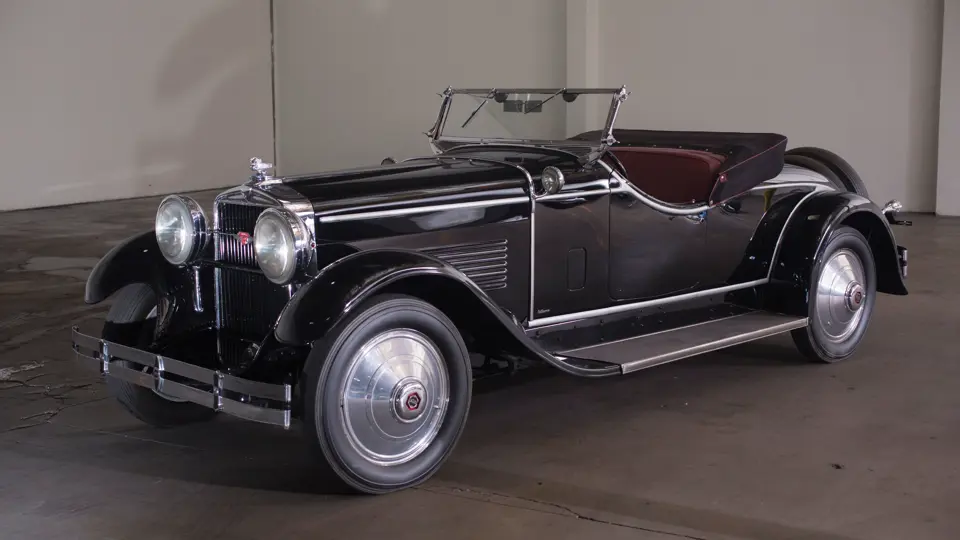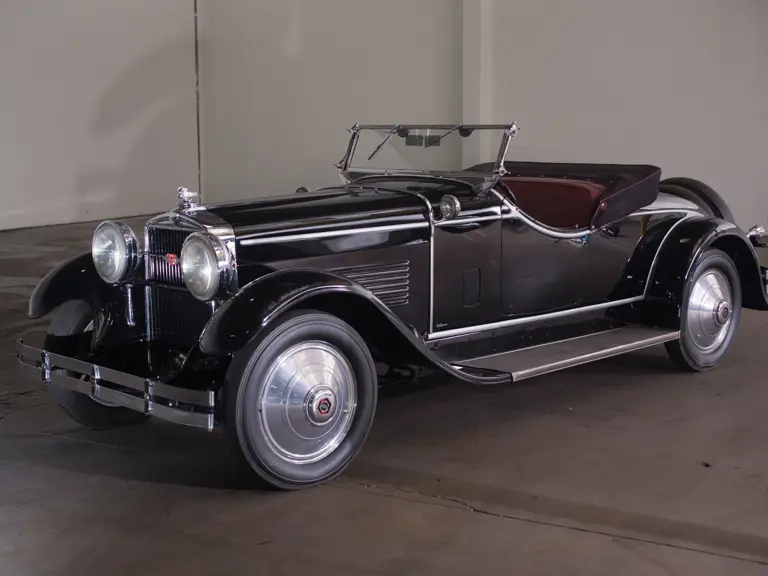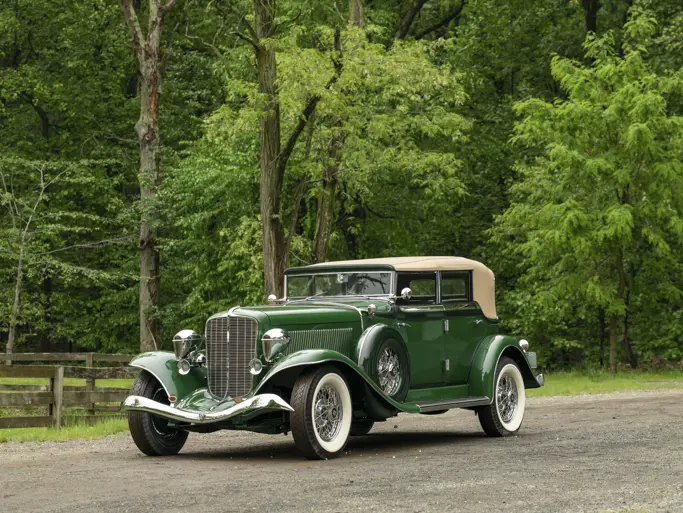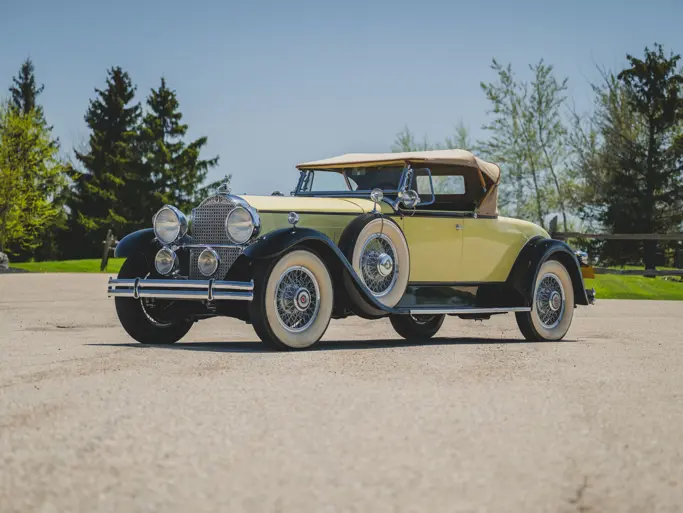
1929 Stutz Model M Vertical Eight
{{lr.item.text}}
$176,000 USD | Sold
{{bidding.lot.reserveStatusFormatted}}
- 322.1-cid, 113-hp single overhead camshaft inline eight-cylinder engine, four-speed manual transmission
- Gloss black with subtle silver moldings, cutout doors, black canvas top with red piping, matching boot. Red leather seats with matching carpet
- At one time part of the legendary A.K. Miller collection in Vermont
- Superb thorough nut-and-bolt restoration by a well-known and respected classic car specialist
- In spectacular condition
Coachwork by LeBaron
Chassis no. M24 SY01S
Engine no. 30046
322.1-cid, 113-hp single overhead camshaft inline eight-cylinder engine, four-speed manual transmission, solid front axle and live rear axle with semi-elliptic leaf springs, and four-wheel vacuum-assisted hydraulic drum brakes. Wheelbase: 134.5-inches
Stutz was advertised as the “car that made good in a day.” The day was May 30, 1911, when a car designed by Harry Clayton Stutz competed in the inaugural Indianapolis 500. It did not win – that honor went to Ray Harroun in a Marmon – but its eleventh-place finish, for a car completed just days before the race, was sufficiently remarkable to launch production of the Stutz Model A and one of the world’s most memorable automobile slogans. Most notorious among early Stutz cars was the Bearcat speedster model, and a racing team, called the “White Squadron,” held sway with specially-designed overhead cam four-valve engines from 1915 to 1917.
After a period of corporate instability and the departure of Harry Stutz, the Stutz Motor Car Company came under the direction of Hungarian-born engineer Fredrick Moskovics. Moskovics completely redesigned the Stutz car, with a new six-cylinder overhead cam engine, a double-drop chassis frame and worm gear rear axle, safety glass and four wheel hydraulic brakes. The latter feature was noteworthy for its design. Termed “hydrostatic,” the system used water with an anti-freeze additive, but for one year only. Although somewhat boxy in comparison to competitors, the Stutz rode several inches lower. “The Safety Stutz,” it was called, with the “Vertical 8” engine. These terms would be used for the remainder of the company’s life.
The Model M for 1929 was the last for which Moskovics was responsible. The engine was enlarged by boring it an eighth of an inch, resulting in 322.1 cubic inch displacement. A new four-speed transmission from Detroit Gear and Machine gave greater versatility, although the first gear had a stump-pulling ratio so was seldom used on the road. A novel “Noback” device on the gearbox provided a mechanical hill-holding function, and a B-K vacuum booster assisted Stutz’s already-capable hydraulic brakes. Bijur central lubrication was standard equipment. Bodies for open styles were by LeBaron, delivered in the white for finishing at Indianapolis.
LeBaron Carrossiers, Inc. was formed in New York City in 1920 by Raymond Dietrich and Thomas Hibbard. Former Brewster designers, they chose the name for its French connotations and rented an office at Columbus Circle, in the same building with Fleetwood’s sales office. Their intention was not to build custom bodies but to design them for clients and to have them constructed by independent coachbuilders. Their first customer was the New York branch manager for Packard, who commissioned them to draw up a seven-passenger limousine. Fleetwood built the body, and the customer was so satisfied that referrals began to come in. The New York agency for Lincoln ordered a short run of three body styles, a roadster, a berline and a dual-cowl phaeton. LeBaron was off and running.
Dietrich and Hibbard took in Ralph Roberts, a recent Dartmouth graduate, as a partner. Soon LeBaron was supplying bodies for chassis supplied by New York dealers for Rolls-Royce, Mercedes-Benz, Minerva, Fiat, Hispano-Suiza, Packard, Cadillac and Pierce-Arrow, among others. The first two assignments from automobile manufacturers came in 1922 and 1923: eight body styles for Crane-Simplex and seven for Locomobile. Hibbard left for Europe in 1923, where he associated with Howard “Dutch” Darrin in Hibbard & Darrin.
Late in 1923, the owners of the Bridgeport Body Company in Bridgeport, Connecticut, proposed to the remaining LeBaron partners that they become design partners, in exchange for stock. This had the win-win effect of providing Bridgeport Body with designers on tap, and giving LeBaron a less-independent crew of constructors. Now called LeBaron, Inc., the company hired Roland Stickney and Werner Gubitz from Locomobile as delineators and illustrators, for while Dietrich had design responsibility he was often traveling and coordinating. The shop staff numbered about 50.
In 1923, Dietrich had met Edsel Ford at the New York Auto Show. The two hit it off, and a big order from Lincoln resulted. Shortly, Lincoln became LeBaron’s best customer. Edsel was so pleased that he tried to get Dietrich and Roberts to move to Detroit. Both men were invited to the Motor City, ostensibly for technical discussions but the agenda really concerned a buyout. Dietrich went alone because Roberts was ill, and, overwhelmed by a generous offer, sold out his share of LeBaron and moved to Michigan. LeBaron at this time was building bodies for Lincoln, Packard, Pierce-Arrow and Stutz, as well as a number of European makes under commission from their New York distributors.
Stutz Speesters could have either straight or “cutout” doors. This car, in deep, gloss black with subtle silver moldings, has the desirable cutout doors and a black canvas top with red piping and a matching boot. Red leather seats with matching carpet complete the cockpit complement.
Reportedly part of the legendary A.K. Miller collection in Vermont, it was acquired by a collector who commissioned a thorough nut-and-bolt restoration by a well-known and respected classic car specialist. The quality of restoration is superb, with excellent contours, paint and brightwork. The car runs on 6.00-20 Lester blackwall tires, nicely set off by spun aluminum wheel discs. Stutz made good in a day. This Stutz is very, very good, every day.


 | Burbank, California
| Burbank, California


